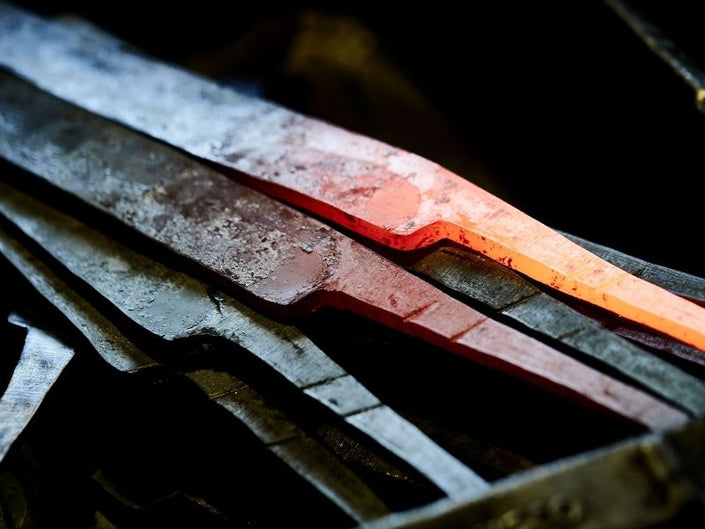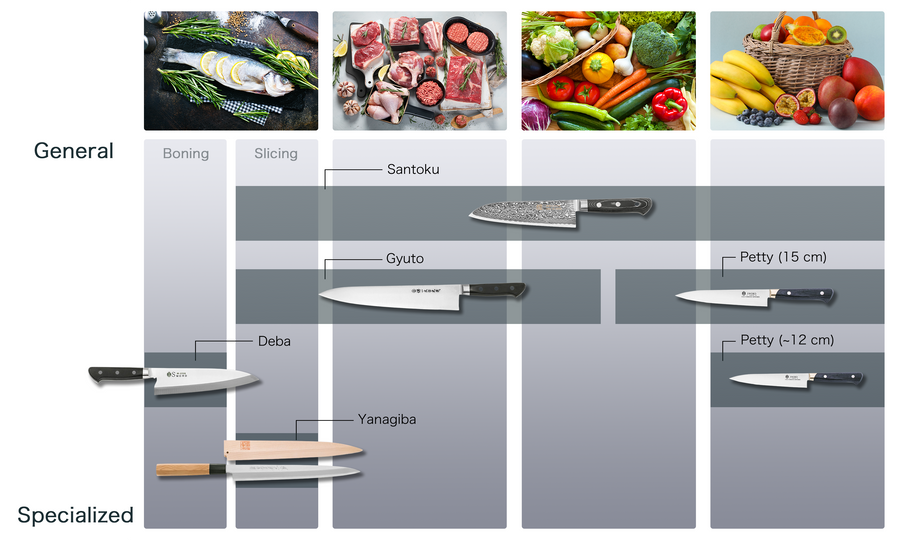
¿Qué es Montanren?
Montanren se refiere al patrón ondulado en el reverso de la hoja, donde el límite entre el hierro blando y el acero es ondulado como el patrón de la hoja de una espada japonesa. Esto requiere un alto nivel de habilidad, y sólo hay un número limitado de artesanos en Sakai capaces de hacerlo.
Acero blanco nº 1 Serie Montanren

El acero blanco n.º 1 (Shirogami n.º 1) es el más parecido al tamahagane utilizado en espadas y es ideal para hojas con alto contenido en carbono y pocas impurezas.
Debido a esto, el tratamiento térmico en el proceso Hizukuri (calentamiento y martilleo para dar la forma final a los cuchillos) es extremadamente difícil, y sólo hay un número limitado de artesanos en Sakai que puedan forjar este acero.
En Sakai Ichimonji Mitsuhide, el afilado, que es la mayor característica del Acero Blanco nº 1, se maximiza mediante el proceso Hizukuri de los mejores artesanos. La hoja se fabrica con una excelente tecnología de forja para crear una hoja tenaz que sea fácil de afilar y que, al mismo tiempo, proporcione un filo duradero.
Estos cuchillos están llenos de la esencia de Sakai Ichimonji Mitsuhide, que siempre da importancia al afilado.

Kiritsuke-Yanagiba
The Kiritsuke Yanagiba is also known as "K-tip Sashimi Knife". It is slightly larger than a regular Yanagiba, with the tip of the blade cut of diagonally giving it a sharper point and more aggressive style. It's used in much the same way as a regular Yanagiba, for slicing Sashimi in one clean stroke. In addition to cutting sashimi, this knife is also used for pulling the skin. Professionals use long Yanagiba knives with blades around 300mm. For home use, Yanagiba knives with a blade of around 210mm are popular.

White Steel #1
The steel closest to Tamahagane, boasting high edge retention while staying easy to sharpen. Recommended for those who seek the most premium and pure sharpness experience.
Carbon Steel
White Steel #1 has higher carbon levels than White Steel #2, giving it both better hardness ratings and longer edge retention. This is done without sacrificing the ease of sharpening and lack of impurities that White Steel is known for, creating an ideal steel for those who want the sharpest cutting experience.
This steel is difficult to forge with, requiring high levels of skill to produce quality knives with. As our knives are forged, quenched and sharpened by skilled artisans, we're able to produce these premium knives.
If you're seeking the ultimate sharpness, White Steel #1 is for you.
*NOTE: Carbon Steel is susceptible to rust if it is not properly cared for. Please clean and dry the blade regularly during use and after use.

Yew octagonal handle
Handle
These handles are made from Yew wood, this wood was historically used in European Longbows due to its density, strength and rot resistance. It was also used by Prince Shotoku , a regent in the Japanese Court.This wood is characterized by its beautiful grain and a color that darkens with age.

Forge Welded
Forging Process
A forge welded blade is essentially a blade made of more than one billet of steel. There are many variations of technique and steel combinations. At its most simple, a forge welded blade is two billets of steel heated and hammer together to form one unified piece. The steel will then be shaped by hammer into the desired blade shape. Hardened and tempered, then ground, sharpened and polished. A forge welded blade has higher strength and edge retention than a stamped blade.

Optional Engraving
Optional Engraving Service
Sakai Ichimonji provides complimentary engraving using either Japanese Kanji or English Alphabet. Please specify your preference. For details, please visit here
A knife store that has supported the history of knives and food culture in Japan.
It has been 600 years since the birth of swordmaking in the Sakai region of Japan. Sakai Ichimonji Mitsuhide's and it's craftsmen continue to build on that legacy by producing the finest blades in Japan.
This is where the culture of completing a dish of sashimi by "just cutting" and the culture of expressing sharpness as "taste" was born.
For 70 years, we have been connecting the spirit of Sakai's craftsmen with the passion of chefs in Osaka's kitchen equipment shopping district, known as the kitchen of Japan.
We are very happy that our knives can be used by people all over the world.
Precautions
After use, wash off any dirt and wipe thoroughly with a dry cloth to remove any moisture. This product is not for use with frozen foods.This product is handmade, so each piece will be different. Please use the weight and length listed as a guide. Each material is natural and may vary in color. It is not the same as the picture.We take great care with our inventory, but in the unlikely event that we are out of stock, we will contact you by email to let you know.













































